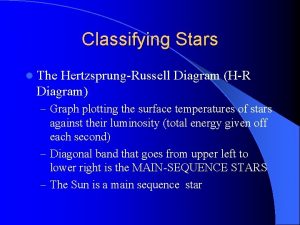The HertzsprungRussell diagram ESS IS 7 Notes 4







- Slides: 7

The Hertzsprung-Russell diagram ESS IS 7 Notes 4 1 of 13 © Boardworks 2009

Power output of a star The amount of energy a star radiates per second, in all directions, is its luminosity. This is its power output. The luminosity of a star is directly proportional to its surface area, and to the fourth power of its temperature. Sun 2 of 13 So a cool red giant can have the same power output as a smaller but hotter star. red giant © Boardworks 2009

Flux and the inverse square law The more distant a star, the dimmer it appears. Why is this? The vacuum of space does not absorb light, so the total amount of light is not reduced as you get further away from the star. But the further away you are, the larger the sphere the light is spread over, so the lower the intensity of the light. This intensity is called flux. Flux is inversely proportional to the square of the distance from a source. 2 d d a This is an inverse square law, like gravity. 4 a 3 of 13 © Boardworks 2009

Apparent magnitude The apparent brightness of a star when viewed from Earth depends on the luminosity of the star, and how far away it is. Flux depends on both of these, but varies over a huge scale. Apparent magnitude (m) uses a logarithmic scale to give an idea of the order of magnitude. Logarithmic scales increase by multiplying, instead of adding. Apparent magnitude makes it possible to put all celestial objects on a scale from roughly – 30 (the Sun) to +30 (the faintest objects visible in the Hubble Space Telescope). 4 of 13 © Boardworks 2009

Absolute magnitude Related to apparent magnitude is absolute magnitude (M). This removes the effect of distance by giving the apparent magnitude of a star if it were at a standard distance of 10 parsecs. Q. If apparent magnitude is a logarithmic scale describing flux, then absolute magnitude is a logarithmic scale describing what other variable? Luminosity. Q. Some objects, such as certain types of supernova, always have the same absolute magnitude. If m and M are known for a particular supernova, what can you determine? How far away it is. 5 of 13 © Boardworks 2009

The Hertzsprung-Russell diagram 6 of 13 © Boardworks 2009

Check Your Understanding of Stars 7 of 13 © Boardworks 2009













